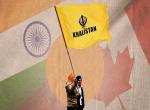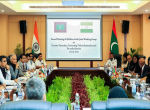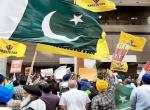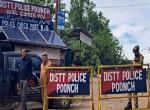The country’s internal security environment, which suffered steady deterioration during UPA’s earlier five-year rule, continues to remain a cause of serious concern. Now that the government is no more fettered by pulls and pressures of coalition partners, which its apologists claimed prevented it from decisive actions in the past, it is regrettable that the situation is showing no signs of abatement. I would like to point out some of the disturbing trends which indicate callous apathy of the government to attend to this vital aspect of governance thereby not only endangering the safety and security of the aam aadmi but also seriously undermining the national interests. These are illustrative and not an exhaustive list of serious acts of commission and omission by the government.
Left Wing Extremism
- Fast spatial growth of the problem. When the UPA government took over there were estimated 76 districts in nine states (MHA Annual Report 2004-05) of the country affected by LWE. Today, as per a study carried out by Centre for Land and Air Warfare Studies, corroborated by many other experts on the subject the number ranges from 203 to 252 districts in 18 states. Practically 35 districts are getting sucked into the vortex of LWE every year despite the prime minister proclaiming on November 4, 2004 that naxalism constitutes the biggest threat facing the country. The pathetic response to a security threat that at the highest level is assessed as the biggest national threat raises serious doubts, both of the capabilities and intentions of the government.
- As per the figures released by the database of International Institute of Strategic Studies giving details of each incident of Left Wing Extremism, the total fatalities for the five-year period from 1999 to 2003 stood at 1,550. As against this the figures for the five-year period from 2004 to 2008 stand at 3,177, depicting an alarming increase of 100 per cent. The current year gives no signs of comfort. In seven months of the current year 475 people including 255 civilians have lost their lives. (Figures given by Mail Today — July 13, 2009). Similarly, the number of Naxalite incidents is also consistently showing an upward trend. In seven months of the current year 1,130 incidents have been reported as against 1,591 in entire 2008. (Figures given by Mail Today — July 13, 2009).
- Other cause of serious concern is the high rate of killing of police personnel. From 2004 to 2008, 877 brave policemen were martyred. While last year 231 police personnel were killed, in seven months of this year the number had touched the figure of 230. The police personnel need better protection against land mines and IED’s as also frequent ambushes. They need better body protection equipment, weapons, communication and transport facilities.
- The strength of armed guerrillas has swelled from less than 7,000 in early 2004 to somewhere around 13,500. Left extremists, today, have many more and much sophisticated weapons; some of them suspected to be from external sources. They raise funds nearly to the tune of Rs 1,200 crore a year and accretion in their financial strength is directly in proportion to funds released for development of Naxal affected areas. One lesson of insurgencies world over is that pumping funds without required infrastructure, accountability and administrative apparatus to ensure its fruitful absorption only enriches the insurgents. The extremists have acquired tactical skills, terrain knowledge and intelligence capabilities, that too in inaccessible rural and forest hinterland, that the security agencies are finding it difficult to cope with.
JAMMU & KASHMIR
The recent reports indicating large-scale infiltration of terrorists and weapons from Pakistan is a matter of serious concern. The army on April 25, 2009, paraded before the media, a Pakistani terrorist named Syed Moinullah Shah, who disclosed that he was member of a group of 120 people, who entered Kashmir earlier that month. The display of weapons recovered on his disclosures was mind boggling, both in quantity and their lethality. In the last few months there have been every day reports of fierce and long encounters between the security forces and the militants indicating presence of a new genre of terrorists — better armed, trained and networked. This exposes persistent claims of the government of sharp improvement in security situation in J&K. Even the army chief has indicated backing to these terrorists of the Pakistanis, and recently told the NDTV that ‘The camps, which were there on the other side, are still existing. There is definite support for infiltration from the other side. The kind of equipment with which these militants have been caught — whether in terms of weapons or communication equipment — indicate the tremendous supports given to them by the other side’. Quoting official sources Asian Age (April 24, 2009), reported that, ‘Available inputs confirm that 1,000 terrorists will be sent from 26 different terror camps located in several areas of Pakistan’. The report quoting an official further added, ‘Lashkar has at least 30 terror camps located in Muzaffarabad and Kotli. There are confirmed reports that at least 550 Lashkar militants are being prepared by their handlers for carrying out terror activities in India. They will also be sent to India by June end’. All these developments are indicative of a fast deteriorating security scenario with grave threats to India’s sovereignty and integrity.
It is surprising that the joint communiqué signed by the PM with his Pakistani counterpart makes no mention of continuing support to terrorists by Pakistan, the presence of camps there, continuous infiltration of terrorists from across the border but instead Pakistan’s concern on Balochistan has been added.
TERRORISM
Terrorism continues to be the most serious threat confronting the nation; most of it. While it has a profound external component, efforts have also been made within the country to subvert some misguided youth. The government instead of dealing with the problem firmly and by building national capacities to contain and counter them is pursuing illusive diplomacy to deal with it.
In September 2006, the government claimed a major break-through in Havana when it declared that Pakistan was a terrorist victim and not a terrorist sponsoring state. In a statement the government said; ‘The fact is, terrorism is a threat to Pakistan and it has been a threat to India. We need to have a collective mechanism to deal with it’. Surprisingly, it came just after Mumbai blasts of July 11, 2006 in which 201 persons were killed and 714 injured in seven serial blasts. After the blasts the prime minister had said, “We are certain that the terror modules responsible for the Mumbai blasts are instigated, inspired and supported by the elements across the border”. And what was the consequence of this capitulation. From that date till Mumbai carnage of November 26, 2008, 18 major incidents of terrorist attacks took place in the country.
Pakistan let loose reign of terror in which 602 persons were killed and 1,649 were injured in a span of two years. And, what is the lesson we have learnt from this? We tamely signed a joint communiqué with Pakistan resuming the dialogue process in which instead of articulating our concerns as an aggrieved party we agreed that comprehensive dialogue would be de-linked from terrorism. Pakistan’s policy is very clear to coerce India into submission through bleeding it continuously, this was best articulated by Musharraf who during the SAARC summit in Nepal in January 2002 said that the Kashmir issue ‘was linked to Indian terrorism and cannot be separated’.
Despite repeated assurances by the government and claims of major diplomatic victory, Pakistan has taken no tangible and verifiable steps to stop its terrorist offensive against India and bring to book the culprits of 26/11 Mumbai blasts. It is not only that the appeal for detention of Hafiz Saeed has been withdrawn but no accomplices and associates of the 10 Pakistani terrorists who attacked Mumbai have been arrested or proceeded against. As the investigations have revealed the planning and preparations of Mumbai attacks took over one year in which Kasab and his associates were recruited, imparted training, provided weapon, communication lines were established, intelligence was collected, safe houses in Pakistan were established, their journey to Mumbai through sea was planned and various logistic arrangements were tied up. Most of it happened on Pakistani soil. It is not only the senior leaders of Lashkar-e-Toiba like Hafiz Saeed, Zakiur Rehman Lakhvi and Zarar Shah who were involved but also tens of others were active accomplices in this plan. Pakistan has taken no action against them. It is only hoodwinking the international opinion by pertaining to be keen to take action. But, what is most regrettable is that India lends credence and legitimacy to Pakistani claim by not only resuming talks but also agreeing to have intelligence cooperation between the two countries.
We would like the government to take immediate steps if it wants to make its electoral promise of zero-level tolerance to terrorism a reality rather than a mere electioneering slogan:
- Strengthen its intelligence apparatus, particularly at the operational level to pre-empt, prevent and punish the terrorists
- Accord early approval to various long pending state legislations against organised crimes
- Strengthen border security with higher technological support to control terrorist infiltration
- To restore the confidence of the people in the rule of law, execute the punishment accorded to Afzal Guru, the convict in Parliament attack case
- Establish special courts for speedy disposal of terrorism cases
- To strengthen counter-terrorist laws including bringing about changes in the evidence and criminal procedure laws to effectively deal with terrorist and their supporters
- Pursuing a two-pronged strategy in dealing with the neighbouring countries — generally promote good and friendly bilateral relations with all neighbours for mutual benefit and adopt a firm and unambiguous policy towards those meddling with India’s internal security and take effective measures to neutralise infrastructure/capability located therein, which is currently utilised by terrorists to unleash terror attacks in India.
- Set up national data bank of terrorist organisations and terrorists with nationwide e-connectivity
- Launch a major programme to assist state governments in the modernisation, up-gradation and restructuring of state police forces
NATIONAL IDENTITY CARD
On April 17, 2000 the Government of India appointed a Group of Ministers (GoM) chaired by the home minister with defence minister, external affairs minister and finance minister as its members to review the entire gamut of national security and recommend ways and means to revamp it in an integrated manner. The GoM submitted its report in February 2001, which was later accepted in its entirety by the Government of India in April 2001.
In its report, acknowledging that ‘illegal migration has assumed serious proportions’ the GoM recommended ‘there should be compulsory registration of citizens and non-citizens living in India. All citizens should be issued multi purpose identity cards and non-citizens should be issued identity cards of different colour and design. This should be introduced initially in the border districts and then extended to the hinterland progressively’.
The Government of India accepted the recommendation. Accordingly, the Citizenship Act 1955 was amended in December, 2003 to provide for compulsory registration of all citizens and issuance of national identity cards. A detailed system after series of inter-departmental deliberations and consultations were worked out for linking of the full details and entries from the national to state, district and sub-district levels. After soliciting the help of some IT experts a highly sophisticated software programme was designed. Through an elaborate and near automated system it was designed to provide unique national identity number to each Indian citizen above the age of sixteen and link it to birth and death records, passport details, record of property holdings, driving licence, income tax return, foreign travel records through emigration bureau, criminal records, educational institutions attended etc. It also envisaged biometric recognition details besides fingerprints. Responsibilities were delineated and the state governments approached for their role and support in making the plan a success.
When the change of government took place in April 2004 the scheme was at the takeoff stage. The funds had been allocated and a detailed action plan had been operationalised. Pilot projects had been launched in some border areas and necessary improvements brought about on the basis of experience gained.
It is quite confusing now the government has come with the new idea of unique identity cards trying to reinvent the wheel. While there was an allocation of Rs 44 crore for the MNIC in 2008-09, it has been slashed to Rs 10 lakh in 2009. On the other hand the government has allocated Rs 120 crore for unique identity cards. It is also intriguing why the subject has been shifted from the ministry of home affairs to Planning Commission. I would like to emphasis that issuing of this card was not so much a developmental need as the security need. It is meant to differentiate bona fide Indian citizens from illegal immigrants and foreign terrorists. The government needs to clarify whether the basic purpose for which national identity cards are to be issued has undergone a conceptual change. It also needs to be clarified what is the status of the earlier scheme which the government for the last five years has been claiming was being assiduously pursued.
COMMUNITY POLICING
The participation of citizens is essential for maintenance of internal security for a country as vast and diverse as ours. There are a large number of highly nationalists and contentious citizens who would like to extend their support in not only maintaining peace and order in the civil society but also play a supportive role in combating terrorism, insurgencies, extremism and other forms of threats to the nation. The government should initiate steps to leverage the civil society in maintenance of internal security. It needs to devise innovative methods of involving the community in exercising vigil for the security of neighbourhood on self-help basis and for constructive inter-action with Thana police. Plans for consultation with the community — for instilling a general sense of security and improving the public perception of the police force also needs to be introduced.
The author is a Former Director of the Intelligence Bureau
Published in The New Indian Express dated : August 25, 2009









Post new comment